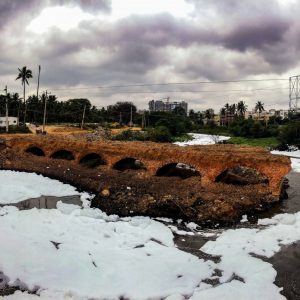Federal Water Tap, March 25: Plants for Energy: DOE Assesses Biomass Potential
The Rundown
- DOE report estimates biomass potential for energy production – and assumes careful stewardship of water to achieve it.
- Federal officials engage state governors on water utility cybersecurity.
- NOAA forecasters warn of water scarcity once again this fall in the lower Mississippi River.
- EPA watchdog finds cost overruns and delays for Gowanus Canal Superfund site remediation.
And lastly, a Senate committee hears testimony about PFAS as hazardous substances.
“We need strategic national policies and investments to help us do several things: first, determine the spread of PFAS contamination; second, identify the health threats that these chemicals can pose; third, explore the best methods to rid our water and lands of them and lastly, collectively find a path forward to making the actual polluters pay while protecting innocent parties.” – Sen. Tom Carper (D-DE) at a committee hearing about designating PFAS as hazardous substances under the federal Superfund law. The EPA has proposed that two such chemicals – PFOA and PFOS – receive that designation, a move that could result in responsible parties being forced to pay for cleanup. A final rule is expected this year.
By the Numbers
$1.1 Billion: Estimated cost of building two sewer overflow tanks for the Gowanus Canal, a Superfund site in New York City. The cost estimate has soared 1,300 percent from the initial budget a decade ago, according to an audit by the EPA Office of Inspector General. Why the spike? Bureaucratic delays have put the project six and a half years behind schedule.
News Briefs
White House Engages States on Water Cybersecurity
The White House sent a letter to state governors, asking for their help in protecting water and wastewater systems from cyberattacks.
The EPA retracted a plan last October to mandate cybersecurity assessments for water systems, after three states sued to overturn the decision. Water industry groups also opposed the plan, claiming a different approach should be used.
So the government pivoted, offering instead a plea.
“We need your support to ensure that all water systems in your state comprehensively assess their current cybersecurity practices to identify any significant vulnerabilities, deploy practices and controls to reduce cybersecurity risks where needed, and exercise plans to prepare for, respond to, and recover from a cyber incident,” wrote Michael Regan, head of the EPA, and Jake Sullivan, the president’s national security adviser.
Studies and Reports
Drought and Flood Outlook – Good and Bad
No major flooding is expected this spring in the United States. But the lower Mississippi River basin could experience another season of low water this fall.
Those are two findings from the NOAA’s seasonal drought and flood outlooks.
What’s the opposite of a silver lining? No major flooding is expected this spring because of low snowpack in the upper Mississippi River basin. However, low snowpack coupled with continued drought conditions in the region means that the lower Mississippi River could again drop to extreme lows in August and September, said Ed Clark, director of NOAA’s National Water Center.
Low river levels last year halted commercial traffic and invited salt water to creep upstream from the Gulf of Mexico. The Army Corps of Engineers had to barge fresh water to several towns in southern Louisiana that found their drinking water too salty.
Plants for Energy
The Department of Energy published a report identifying a pathway for the U.S. to increase the amount of energy it gets from plants.
Biomass – largely farm and timber waste – accounted for 5 percent of U.S. energy production in 2022. About 342 million dry short tons of wood chips and corn stover accounted for this output.
The DOE report claims that biomass energy could triple under the right market conditions, to more than 1 billion tons. Adding untested technologies like algae could push the number higher.
What about water? The analysis assumes that energy crops are not grown with supplemental irrigation and irrigated crops are excluded. These constraints are meant to ensure that available biomass is not causing environmental stress.
The real world, however, might not follow model rules. “Thus, consistent monitoring, assessment, and good management practices are necessary for avoiding or minimizing detrimental effects on soil, water, and ecosystem services,” the report notes.
On the Radar
PFAS in Drinking Water Rule
The EPA is expected to finalize a closely watched rule in the coming weeks regarding national limits on PFAS in drinking water.
Last year, the agency proposed restrictions on six of the chemicals. But lobby groups for local governments have pushed back, arguing that complying with the proposed limits would be prohibitively expensive for them.
Groundwater Depletion in Southeastern Oregon
The U.S. Geological Survey developed a computer model to inform state regulation of groundwater in the Harney basin in southeastern Oregon.
Groundwater in the basin has been depleted by intensive irrigation. The model indicates that the basin has been running annual net deficits – more water out than in – since the 1980s.
Federal Water Tap is a weekly digest spotting trends in U.S. government water policy. To get more water news, follow Circle of Blue on Twitter and sign up for our newsletter.
Brett writes about agriculture, energy, infrastructure, and the politics and economics of water in the United States. He also writes the Federal Water Tap, Circle of Blue’s weekly digest of U.S. government water news. He is the winner of two Society of Environmental Journalists reporting awards, one of the top honors in American environmental journalism: first place for explanatory reporting for a series on septic system pollution in the United States(2016) and third place for beat reporting in a small market (2014). He received the Sierra Club’s Distinguished Service Award in 2018. Brett lives in Seattle, where he hikes the mountains and bakes pies. Contact Brett Walton







Leave a Reply
Want to join the discussion?Feel free to contribute!